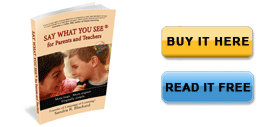Rage Reversal—Getting Kids Heard

In an instant, his world flipped 180 degrees. My son transformed from serene and peaceful to boiling rage. My mouth collapsed to the concrete as I stood in the parking lot of my daughter’s preschool.
His voice thundered. His eyes intensified. His face turned crimson red.
On the outside I was fighting to stay calm, but on the inside I was terrified. His anger explosions seem to come out of the blue. Of course, being late to pick up my daughter and feeling like other parents were intensely staring me down wasn’t helping any.
The hidden meaning behind angry and aggressive behaviors.
In short, kids are fighting desperately to matter. Anger and aggression is often a missed communication about what the child wants not mattering, which to a child equates to not mattering as a person.
Everything children say and do is a communication. They absolutely must continue to communicate until heard. This is human nature; so if kids don’t get to express themselves, they will either escalate their actions now or store it up for later.
When unheard upsets build, kids will turn to aggressive and challenging behaviors to show you instead. Those behaviors can be seen as a cry for help. Things can worsen quickly if missed communications build over time. When parents or caregivers try to stop or scare kids out of angry and aggressive behavior, kids may try to prove that their upsets are very real by further escalating their behaviors.
Help your child step out of angry and aggressive behavior.
This is why Language of Listening®, the 3-part parenting framework that I use, is so useful. Because even when you’re eyeballs deep in a stressful parenting situation, you’ll know how to respond to your kids.
Get on your child’s side.
The first part of Language of Listening is almost always SAY WHAT YOU SEE®, which means you describe the situation without any judgement, questions, teaching or fixing. This immediately re-connects you with your child and gets you on the same side. When helping a child struggling with anger and aggression, getting on the same side is paramount.
Angry kids are experiencing a whole lot of upset and angst and the simplest way to help them calm down is to help them feel heard and understood. (Remember: Understanding your child’s point of view is not the same as agreeing with it or condoning a behavior.)
Here are some ways to use SAY WHAT YOU SEE with an angry child…
1. SAY the feeling.
“You’re really angry!”
“You’re enraged, frustrated and completely beside yourself!”
2. SAY what the child’s thinking.
“This isn’t what you wanted! You wanted to… And now you can’t. It’s no wonder you feel put out!”
“You think this isn’t fair. It’s like everyone makes all the decisions and no one understands your side of things!”
3. SAY what your child’s body is doing.
“Your heart is racing. Your arms are shaking. Your voice is rattling.”
“Your cheeks are hot and your throat feels tight. You’re so angry, your whole body is reacting!”
“You’re so upset, you can’t even bring yourself to talk right now.”
Getting on your child’s side is the first step towards facilitating anger in a healthy way. The more you can “match or mirror” your child’s intensity and facial expressions in a genuine way, the faster they know you understand.
Facilitate the anger.
Once kids reach the point of anger and aggression, it’s all about meeting a need for power. In order for your child to calm down, this need absolutely must be met in some way. This is why kids’ anger will intensify or explode again later if they aren’t allowed to first express their feelings and second meet their need for power.
The simplest way to meet an angry child’s need for power is to offer a way they CAN express their anger and aggression. This is the CAN DO part of Language of Listening.
Simple ways to use CAN DOs with an angry child…
1. Offer the child something safe to hit, kick or bite.
If the child is already hitting, kicking or biting, then offer a soft cushion or object to hit, kick or bite. Kids who learn to channel that anger towards a safe object are creating a healthy solution.
If you think about it, there are lots of situations where aggression IS okay. Boxers hit each other for a living. Hunters shoot and kill animals for sport. Every day parents hit the gym to sock and jab a punching bag.
Rather than capping your child’s anger, which will just build and explode again later, you are helping him or her release aggression without hurting others or themselves. The sooner you can help your child discover a safe outlet, the quicker they can meet their need for power and calm themselves down.
2. Offer the child something to rip or scream into.
Your child could rip paper or boxes. Or kids could scream into a cushion. If you’re out in public, head outside to the car and scream in the car.
Again, this can feel like you are condoning anger (and actually you are because you are not trying to stop the feeling, just helping your child find an acceptable way to get it out). CAN DOs help meet the need for power quickly. AND…once the need for power is met is the exact moment your child is open and ready to listen to guidance.
3. Turn the problem-solving over to the child.
Anything the child can do that works within your parenting boundary is a CAN DO. You can put your child in the lead and encourage them to come up with something themselves by saying…
“There must be something you can do!”
“There must be a way you can…!”
Dive into “Success Training” once everyone is calm.
Success Training will help your child discover his or her inner greatness. Every child is capable of controlling their emotional expressions; it’s only a matter of helping them recognize it. This is the STRENGTHS part of Language of Listening where you can help your child see what they did right in a situation and apply it to future situations.
Here are some ways to use STRENGTHs with an angry child…
“You were so upset and angry; it was hard to find a way out. But you calmed yourself. That took a lot of self-control.”
“You took a really challenging situation and found a solution that would work for everyone. You accomplished a huge amount of problem-solving in a short amount of time!”
“What you did worked! You were filled with rage. Now, you’re calm and relaxed. You are in total control of your emotions! Next time, this is a strategy you can use.”
Our actual dialog.
This is what happened when I responded to my angry child without saying what I saw…
As my son eagerly jumped out of the car, he pleaded, “Can I bring this book inside with me?”
“You know the rule. We can’t bring anything inside the preschool with us. As soon as we get back to the car, you can have the book.”
This is the moment that fueled his anger. And at first glance, my brain told me say, “Oh stop it. It’s just a silly book. You can have it again in 5 minutes.” But I knew that using Language of Listening instead of logical explanations would be quicker in the long run.
Here’s what happened when I said what he was thinking instead…
“Ugh. All you want to do is bring this tiny book inside and you can’t. That is soooo upsetting! These rules are horrible! To top it all off, there were probably a TON of rules you had to follow earlier today at school that you didn’t want to. This is really hard for you!”
“Yeah.” {wails}
“There’s just something about this book. It’s important to you. There must be something important to you that we CAN DO on our way into the preschool.”
{silence, more tears}
“Hmmm…You could ride on my back on the way in. Or we could make silly faces while we jump inside or maybe we could…”
“Oh, I know! I want us to stick our tongues out at each other while we walk inside.”
“Okay buddy. That’s not what I expected. But okay. That would work for me.”
It’s simple to start.
No matter your child’s ability or age, it’s simple to implement Language of Listening. More than anything, we all want to feel heard and understood. Anger and aggression is simply a way that kids communicate to show you instead of telling you.
Lauren Tamm is an authorized Language of Listening® coach and the author of The Military Wife and Mom blog where she writes on practical parenting, enjoying motherhood, and thriving through the ups and downs of military life. Connect with her on Facebook or Pinterest.
1 Comment







This feels like it describes my 6 year old so much! Thank you for the tips!